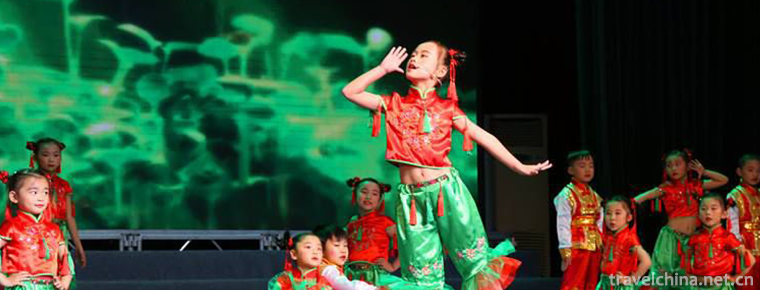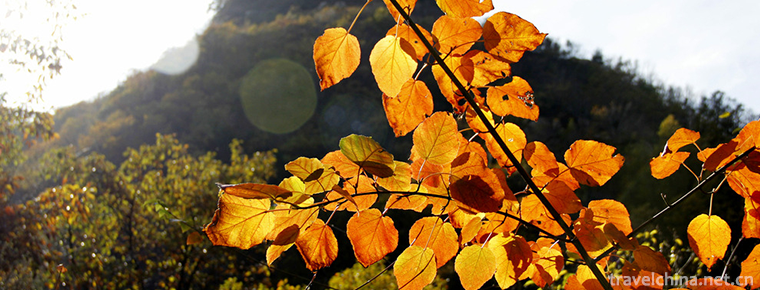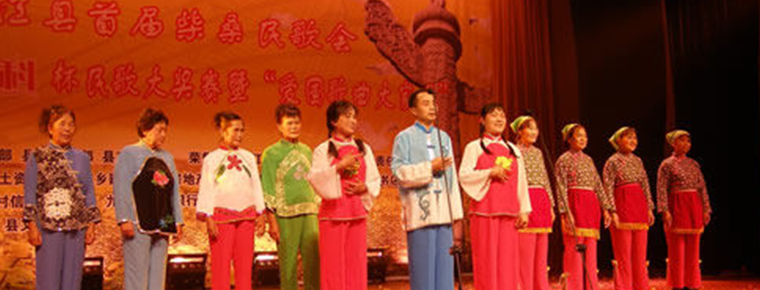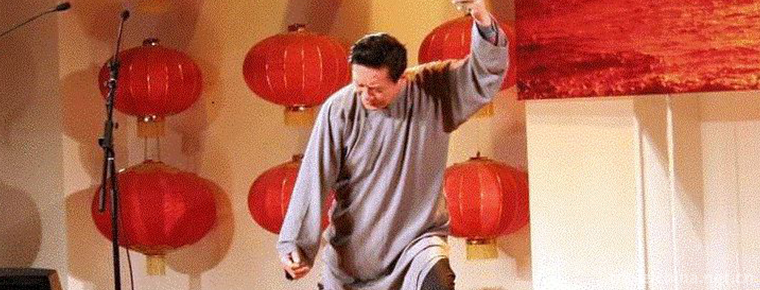2019-02-06

- By ChinaWiki.net
- Chinese Edition
- 2019-04-25
Dang Tu folk songs
Dangtu Folk Song is one of the national intangible cultural heritages of the local traditional music in Ma'anshan City, Anhui Province.
As early as the Six Dynasties, Duan Tu's folk songs were recorded. The famous "White Song and Dance" presided over by Liu Yu, the emperor of Liu Song, was one of the lines of Du's folk songs. Dangtu folk songs are rich in language, complete in structure, diverse in tune and unique in singing, showing the charm of distinctive local folk music and language art. Representatives of the repertoire are "beat wheat song", "cattle song" and "elder sister in the field picking up beans" and so on.
On May 20, 2006, Dangtu Folk Songs were approved by the State Council of the People's Republic of China to be included in the first batch of national intangible cultural heritage lists. Number: II-5.
historical origin
As early as the Six Dynasties (220-589), Tu's folk songs were recorded. The famous "White Song and Dance" presided over by Liu Yu, Emperor of Liu Song, was one of Tu's folk songs.
Li Zhiyi, a poet of the Northern Song Dynasty who lived in Dangtu for a long time, sang more than 20 songs of "Tianfu Ta Ge" and "I live at the head of the Yangtze River and you live at the end of the Yangtze River".
In the Qing Dynasty, Huang Yan, Dangtu, represented the highest artistic level of Dangtu's folk songs at that time with more than 50 Yuhu Zhuzhi Ci poems as the main content of local customs and customs.
After 1949, Dangtu people created folk songs and sang folk songs. By the end of 1950s, Dangtu people had reached its peak.
Cultural characteristics
Dangtu folk songs are mostly three-character, five-character and seven-character sentences. Although they are handed down orally, there are quite a number of folk songs with elegant language and harmonious rhyme, which have obvious traces of literati processing. At the same time, Dangdu dialect is also reflected in all kinds of folk songs. It is these difficult to understand dialects that strengthen the regional characteristics of folk songs. In order to express their feelings, Dangtu folk songs also use onomatopoeic words and interjections as the backing for some key nouns and adjectives to overlap intentionally in order to strengthen emotions. Although the length is different, most of Tu's folk songs have a relatively complete structure. Productive folk songs often fully describe the labor process, such as "Liao Dao Song"; life folk songs, elegant taste, such as "Shanbo visit friends" and "Wangmiao Fair"; Lyric folk songs such as "When painting scenery" often start from describing the beautiful scenery of mountains and rivers, and then transit to the love of home.
The tunes of Dangtu folk songs are rich and colorful because of the different contents, themes and genres of the lyrics. The tune of folk songs is high, loud and free; the work chant is often in accordance with the rhythm of labor, which is more pleasant and fixed, easy to coordinate action, suitable for singing while doing; the folk songs of Tiange and Yangge are slow in rhythm. Folk songs with love themes are more tactful, while those with hymns are longer.
Dangtu folk songs are also different in style because of the different singers and singing occasions. Productive folk songs are mostly sung by adult men and women in high tunes in the field. The singers are full of emotions. They often have free prolonged tones in the high tune area. They are mostly composed of singers and singers, singing three sighs, which coincides with the enthusiasm and unrestrained feelings and personality of farmers. The folk songs such as "Cattle Song" and "Tea Picking Song" are mostly in flat tune, although they have a fixed melody, but the emotions and wisdom of the singers and other factors. Influences, or bright, or soothing, fixed melody will change accordingly; life folk songs mostly in leisure or important festivals, in the venue or indoor singing, the volume is small, singing one and one, teasing each other, more witty, singers are mostly women, they express their yearning for a better life in the future, the joy of harvest vividly; love folk songs, because inside. Tolerance differences, or unrestrained, or romantic, or implicit, or lament.
Theme works
Dangtu folk song has a large number of subjects and almost involves all aspects of social life. At the same time, folk songs in plains, Polders and hilly and mountainous areas are colorful, forming a variety of genres. Chant, cattle song and dance tune are popular in Dangtu Dagongxu area, boat song, Fishing Song and lantern song are popular in Bowang, Huyang and Xinshi area, Yangko, couplet song and door song are popular in quarrying stones along the river, Holi and Xinqiao area. Dangtu folk songs are rich in language, complete in structure, diverse in tune and unique in singing, showing the charm of distinctive local folk music and language art. Representatives of the repertoire are "Damai Ge", "Cattle Song" and "Sister in the Field Grabbing Beans" and so on.
Popular area
Dangtu folk songs are widely distributed in Maanshan, Dangtu, Wuhu, Wuhu, Fanchang and Hexian districts on the other side of the Yangtze River north of Maanshan.
Inheritance and protection
Inheritance value
When Tu folk songs are the crystallization of the wisdom of the Tu people, they are the typical representatives of the oral creation, oral singing and oral transmission of the cultural manifestations of the working people. After the artistic processing of the past generations of cultural people, they have a high historical value, cultural value and artistic value. They are rare works of music and language art.
In the long history of human development, various levels of music play their respective roles in different social strata. Folk songs belong to the spiritual culture of the lowest working people in different social and historical stages. It has simple aesthetic value, cultural inheritance value and potential economic value.
1. Aesthetic Value
Dangtu Folk Song is a verbal art form which originates from emotions. It is the most common and plain spiritual culture of ordinary people in Dangtu. It meets people's spiritual needs and gives people the enjoyment of beauty. Dangtu folk song is a real grass-roots culture. Because it is produced in people's real life, it is the most direct expression of people's life emotions, the direct expression of people's life joys, sorrows, love and hatred. It brings people aesthetic experience that other artistic forms can not achieve. Its aesthetic value is mainly manifested in:
1. Simplicity and Beauty
When Tu's folk song is artistic beauty, it is simple, sincere and simple. Folk song singing generally does not need accompaniment, makeup and props. It is the emotional expression of people's hearts to nature, society, labor, themselves and other people (sweethearts). People want to sing and sing, originated from the natural emotional expression in the original ecological environment, full of strong artistic vitality, it is the external expression of people's simple aesthetic taste and pure emotion, reflecting the simple beauty of life of Dangdu folk songs. Here is the example of "Dowry".
"Dowry" uses relatively few tone modifiers in tune, and its tone is bright, concise and bright, with the beauty of simplicity. The lyrics of the song are simple and innocent, reflecting the wedding customs of the folk "noisy" brides, depicting the shy psychological state of the bride-in-law when she first arrived at her mother-in-law's house, and the whole song is full of the artistic beauty of the folk simplicity and exudes a strong local flavor. Dangtu folk song reflects people's daily production and life. "The beauty implied in Dangtu folk song is a complex beauty and cultural beauty that integrates with the life style, living environment, life phenomena, customs, language and clothing of agricultural society. It shows the unique aesthetic value and vitality of Dangtu culture and reflects people's simple life.
2. Beauty of wit and interest
Wisdom interest is a kind of wisdom interest. With wisdom, folk people increase their life interest in folk song singing, so as to entertain themselves and others. Singers and listeners can appreciate their unique aesthetic interest, which is deeply loved by Dangdu people. When Tu's folk song expresses freely in emotion, the lyrics are bold and bold, imaginative and full of wit and interest. Here's a case study of Pair Flowers.
The simple and lively style of this song adds the beauty of wit and interest to folk songs. It reflects the gentle and deep feelings of Dangtu folk songs, the rich and delicate expression techniques in the singing process, especially the extensive use of linings and linings, the meticulous embellishment of relief tones, Boeing and so on, which makes Jiangnan Shuixiang folk songs full of rich flavor of life.
3. Beauty of Idea
Dangtu folk song is the crystallization of the collective wisdom of the working people. After historical honing, its aesthetic characteristics are not only reflected in the tune and lyrics, but also in the intention, reflecting the connotation of the working people's generous inclusiveness and positive attitude towards life. Here, take "Dowry" as an example.
The first part of the song "Dowry" presents a real life scene - making a new house. The middle part of the song triggers a conflict of ideas. Why does the bride always carry a red bag with her and refuse to lose it? Give people an unexpected sense of abruptness, followed by a concise and lively "pull" to give people endless deliberate beauty. The whole folk song does not have any special vivid description of the new daughter-in-law. It ends with some intriguing science and technology books and awards. It outlines the inner beauty of the new daughter-in-law and shows the artistic connotation of the folk song's teaching and enjoying.
2. Value of Cultural Inheritance
Folk music, like a mirror, reflects its own cultural and cultural changes in a dynamic form. It directly reflects a nation's history, social work, customs, love and marriage, daily life, is the intimate partner of people's life, assistant in labor, weapon in social struggle, tool for communicating emotions, spreading knowledge, entertainment and recreation, and valuable information for understanding a nation's culture, history, society, folk customs. Dangtu folk song is a part of Dangtu culture. It originates from the bottom of society. The preserved history and culture are the most real. The oral history and culture can often make up for the deficiencies of historical books and help people to understand the past history and culture more truly, comprehensively and closer to their original place. Folk songs, as a form of oral literature and art, represent the actual situation of people's thought, life, culture and other aspects in different historical stages, and have high historical value. At this time, folk songs "music is no longer entertainment, no longer physics, no longer technology and form, nor only aesthetic and educational, but also become culture, and become an important part of the sum of human spirit and material. Points.
Through folk songs, people's living conditions, thoughts and feelings of all walks of life are truly restored. Therefore, folk songs are precious materials of history and culture. From the perspective of "cultural holism" of musical anthropology, the study of Dangtu folk songs not only studies its vivid content, but also studies the whole folk music culture system hidden behind it.
The lyrics of folk songs directly reflect the social and cultural landscape of Dangdu in a period of history, and reflect the natural social life of men and women in the farming society. They have a strong flavor of rural life. From the perspective of musical anthropology, folk songs have gradually evolved into a vivid cultural symbol, through which people can gain insight into more profound cultural information.
Folk culture is the most basic level of social culture, and other types of social culture are developed from the differentiation of folk culture, and stand on the top of the tower of folk culture. Folk music in China can be divided into five categories: folk songs, operas, operas, songs and dances, and instrumental music. Among them, folk songs are the earliest form of music. They play an active role in the formation and development of other folk music. Many songs and dances, operas and instrumental music have been developed directly or indirectly on the basis of folk songs, such as Dangdu's numerous songs and dances such as "Tea Lantern" and "Dragon Boat Rowing". Only minor folk songs, but also gradually developed into local operas. Therefore, Dangtu folk song is the foundation of Dangtu folk music culture, which plays a certain role in cultural inheritance for the development of other Dangtu folk music culture.
The cultural inheritance value of Dangtu folk song lies in that it is the source of modern music creation. The most precious music material of modern music creation comes from folk songs all over the country. Contemporary Chinese composers He Luting, Xu Peidong, Tan Dun and Yin Qing all take national folk music as their source of creation. Their works are welcomed by the people because of their strong national character. Many music works spread rapidly and endure for a long time at home and abroad. The grass-roots music elements of folk songs are the inexhaustible source of composers'music creation. Therefore, collecting the materials of Dudu folk songs with strong characteristics for song creation can not only preserve the traditional cultural background of folk songs, but also add new elements of the times, which is an effective way for the inheritance and development of Dangdu folk music culture.
Potential economic value
Studying Dangtu folk songs not only enriches the folk music culture history of Dangtu, but also enriches the music culture history of Ma'anshan and Anhui. The richness of history and culture brings not only changes in cultural connotation, but also new growth points for regional economy.
Dangtu folk song, as a non-material culture, contains the value of cultural and economic development. Folk song culture economy derived from folk song culture will become a direct economic force for regional development. Maanshan has used poetry, folk songs and other cultural and artistic forms to create a market-oriented operation mode of "cultural platform, economic singing and opera", and has achieved remarkable economic and social benefits. Folk song culture and all kinds of ancillary products derived from folk song culture have shown more and more important economic value and will play a more active role in the sustainable development of local economy and society.
Inheriting characters
Tao Xiaomei, director of Anhui intangible cultural heritage research association, vice-chairman of the Association of Civil Artists and member of the county CPPCC, has won many awards in national, provincial and municipal folk song competitions, and has the reputation of "Folk Song Queen". In April 2018, Tao Xiaomei was selected as the representative successor of the fifth batch of national intangible cultural heritage projects, declaring the area: Ma'anshan City, Anhui Province.
protective measures
On November 18, 2018, Dangtu Folk Song Seminar and the opening ceremony of Dangtu Folk Song Documentary Film were held in Dangtu County Folk Song Art Museum. Experts and scholars from Nanjing Art Institute, Anhui Normal University Music Institute, Anhui University Art Institute and other art fields were gathered at the scene. The participants talked freely about the current situation of Dangtu Folk Song development from various angles, and discussed the existence of Dangtu Folk Song inheritance and protection. At the same time, it puts forward some suggestions on the development of Dangtu folk songs in the future.
As of November 2018, Dangtu County has one provincial folk song inheritance base and 12 practice sites, holding more than 100 folk song exhibitions and exchanges every year. Five consecutive Dangtu Folk Song Contests have been held. Dangtu County Folk Song Art Museum and Tao Xiaomei Folk Song Studio have been set up, which have expanded the influence of Dangtu folk songs and trained many folk song talents. At present, there are one national inheritor, four provincial inheritors and two municipal inheritors.
social influence
international repercussions
On February 5, 2010, Zhang Hongyan, a music teacher of Dangtu County Experimental School, not only sang the Golden Hall in Vienna, Austria, but also won the Golden Prize for carrying forward the intangible cultural heritage of Dangtu folk songs to the world by means of two Dangtu folk songs: Please Go to Dangtu Gexiang and Sing the Green Sea Golden Wave.
Honorary commendation
In the winter of 1954, Dangtu folk song "Damaige" was selected as the first excellent program of folk music and dance concerts in China.
In November 1956, Dangtu Folk Songs continuously participated in folk music and dance concerts in Wuhu area and Anhui Province with the characteristics of large quantity and high quality. Five of them won provincial awards for excellent performances, such as "ripe crops are yellow", "little sister delivers rice to farmland Chong", "cattle song", and "Yulianzi" won provincial performance awards.
Important performance
On the morning of March 26, 2017, a special performance of the Peach Blossom Festival of Daqing Mountain in Dangtu County was held at Taohua Village Cultural Square in Dangtu County, sponsored by Daqingshan Administrative Committee and Dangtu County Cultural and Tourism Committee, and sponsored by Dangtu Cultural Museum.
On July 21, 2018, a series of activities of "Concentric Dream, Non-Legacy Night - Let the World See the Beauty of the Orient" in China began at the National Stadium Bird's Nest. The folk song "Singing the Green Sea Golden Wave" appeared in Beijing Bird's Nest.

Ask a Question
Your email address will not be published.



0 Questions